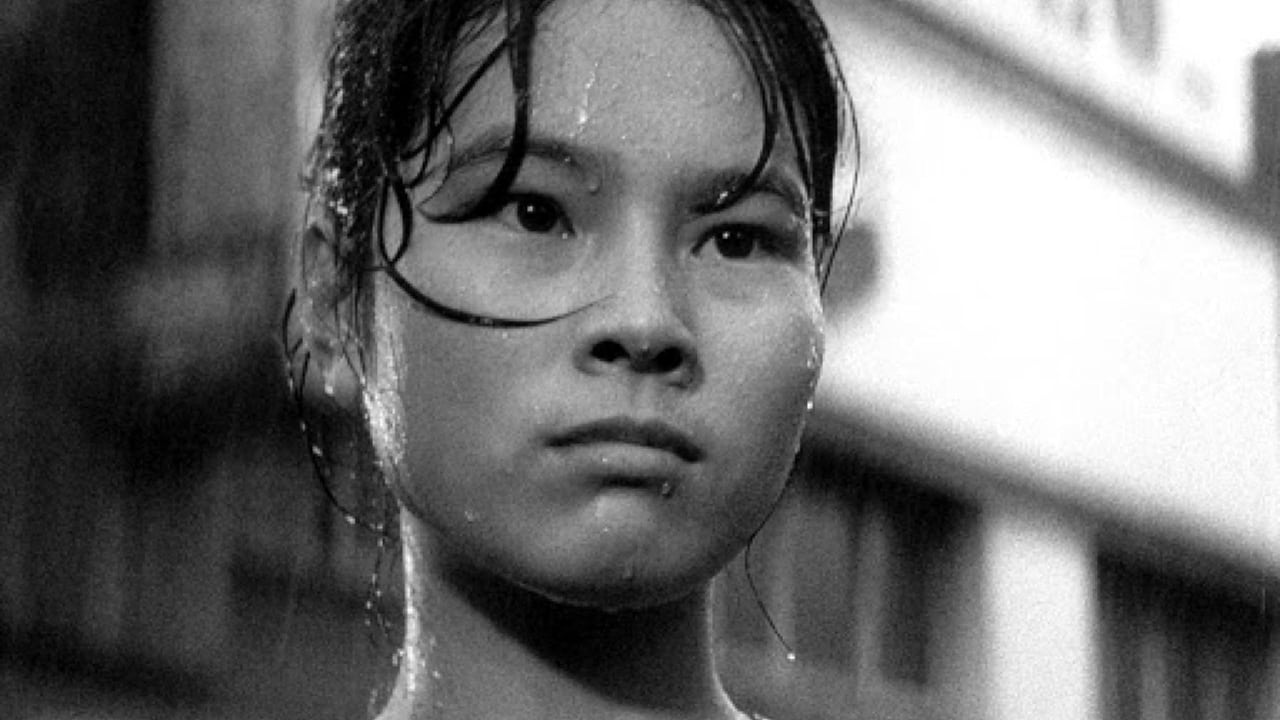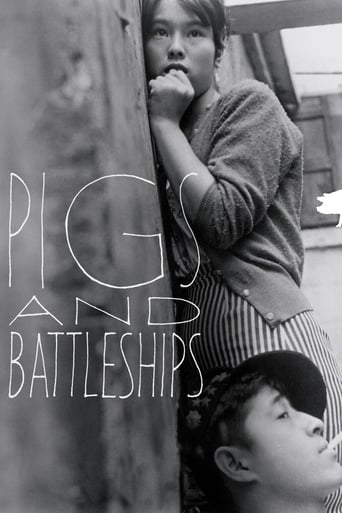



SERIOUSLY. This is what the crap Hollywood still puts out?
View MoreIt was OK. I don't see why everyone loves it so much. It wasn't very smart or deep or well-directed.
View MoreIt's funny, it's tense, it features two great performances from two actors and the director expertly creates a web of odd tension where you actually don't know what is happening for the majority of the run time.
View MoreThe film's masterful storytelling did its job. The message was clear. No need to overdo.
View MoreViewed on DVD. Excellent restoration. Director Shohei Imamura has laid a very large egg with this amateurish, improvised, and not engaging movie. (I'm surprised the studio risked damage to its reputation by even allowing its release to art-house circuits! More about this later.) The plot deals with the lowest of the low level of mob gang members towards the end of the Japanese occupation in the late 1950's. The direction and acting are so bad that it, well, gives the mob a bad name. (You'll see better productions mounted in high-school plays.) Then there are the subtitles. What a mess. They are so amateurishly long and frequent that the viewer has two basic options: (1) focus on the titles and fore go the visuals and most of the dialog; or (2) turn off the subtitles and take your chances with the local (mostly Yokosuka) slang and dialects. (Of course, there is a third alternative: watch the film both ways--recommend only for those with strong constitutions!) Interiors meticulously recreate a portion of the local red-light district. But the action is clearly staged and phony. Same for the real exteriors where the action looks unreal even though the sets are not. Cinematography and lighting (wide-screen, black and white) are excellent. Music seems out of place and mercifully limited mostly to the opening/closing credits. Costumes often look like they are every-day clothes that belong to the actors. Now back to the film's title and its impact on the releasing studio's reputation. The battleships are American and the pigs (the four-legged varieties) are Japanese. But does the Director also have a culturally inappropriate and insulting metaphor in mind? The film is ambiguously anti-American. But seems clearly anti-Japanese. Skip this turkey. WILLIAM FLANIGAN, PhD.
View MoreIn any given economic scenario, it is easy to see how poor people become more poor while their rich counterparts are able to accumulate more wealth. This is depicted in 'Pigs and Battleships' through the sufferings experienced by a young Japanese boy who asks his girl friend to stop the sale of her body. Foreign occupation and rampant corruption are responsible for the decline in moral as well as social values of an occupied land. This idea has found complete favor in this film. A filmmaker cannot turn a blind eye at all to ills of the society in which he or she is living. After the making of Japanese film 'Pigs and Battleships', nobody can dare to accuse iconoclast Japanese director late Shohei Imamura of trying to denigrate Japan's image in the eyes of foreign powers. Director Imamura has always made it a point to have an honest yet frank portrayal of Japan's undesirable people in his films. By remaining honest to himself as well as his art, director Imamura has always portrayed what he has witnessed with his own eyes.
View More"This film is entirely fictional" states the film in the very beginning, lingering purposefully on the faces of bawling drunk Americans wandering the nightly streets, some harassed by, others looking for company. You don't really have to know Imamura at all to recognize the delicious irony. The beginning is so full of impressions, smells and life only Welles' "Touch of Evil" (1958) bests this in how in just a few minutes we're completely in the place and breathe its air. The sweaty chaos of the close-leaning alleys, kisses beneath stairs.Welles is also echoed in the beautifully fluent tracking shots. It's interesting to read Imamura's statements made during the sixties and later, when he recalls Ozu's intention of a highly aestheticized cinema, and his own, more anthropological, perhaps more real. These kinds of comments distracted me for a long time – I wasn't expecting visually strong films, which Imamura's are, neither was I prepared to see so many fresh ideas, of which there are many.I'm not completely satisfied with the ending, but I'll have to wait and see whether it'll grow on me. It is, on one hand, a successful melange of both the sadistic and ironic, but on the other it brings the film to a close perhaps too neatly. Not that I have any idea as to how to make it better, but it's too much of a showdown, and although Imamura plays it to great comic effect with a tragic undersong, it's a bit too excessive to my liking.The Criterion Collection has released this on DVD (Region 1) as part of the 'Pigs, Pimps & Prostitutes' boxset that also includes "Akasen satsui" ('Intentions of Murder', 1963) and "Nippin konchûki" ('The Insect Woman', 1963). Masters of Cinema have released this on a Region B Blu- ray that also includes an early Imamura film, his debut actually, "Nusumareta yokujô" ('Stolen Desire', 1958).
View MoreShohei Imamura films continue to be showcased in the Japanese Film Festival, and Hogs and Warships is a tale of pimps, gangsters and prostitutes put together in a melting pot that is the streets of Yokosuka, a port town where US Navy personnel spend their R&R in postwar Japan. And I suppose you know that means painting the town red with drink and women, with the Japanese folk all eager to make a quick buck through the provision of services. I think there is no love shown here in painting, through the course of the film, how the pigs can refer to both the American soldiers - where the rowdy rank and file chasing skirts to bed, and the officers portrayed as more than willing to keep mistresses - and the Japanese men themselves who are pimping their town/city/country, where everyone's thinking of making good money in the shortest possible time. As an outcome, there's a whole load of black comedy that Imamura crafts in the film, where gangsters are constantly scheming and looking to outwit rivals, and the women well, relegated to either the backlanes waiting for pimps to bring in business, or pandering to the notion of being a kept woman for a better life overseas.Hogs and Warships, or Pigs and Battleships, begins with showing the bleak picture of the impoverished in Yokosuka out to make a living through all means possible, despite the clamp down on bars and establishments by the Shore Patrol, that seems more symbolic and hence hypocritical in nature even, where a prostitute lashes out at a SP personnel for visiting her brothel just before the closure. After a quick introduction we're introduced to the protagonists in the lovebird couple Kinta (Hiroyuki Nagato) and Haruko (Jitsuko Yoshimura, who followed up this film with Onibaba, also featured in last year's JFF), one on each side of the sexes to touch on their respective strategies to better their lives.Kinta's the quintessential easy-going, happy go lucky and unlikely gangster, where he thinks the money is with running with the gangsters, although he soon finds out his recruitment besides helping to operate the black market hog business, is to become the fall guy for practically everything that goes wrong for the gang, from the comical disposal of a corpse, to taking the rap for the gangster chief should it come down to that. With that comes the promise of riches beyond his imagination, with which he can pursue his dream of becoming a band manager.Haruko is that steely lady that we've come accustomed to with Imamura's characterization of the fairer sex. Like the other romantic leading ladies in films like A Flame at the Pier and Good for Nothing, they possess this inexplicable hope that they are able to change their man through love. Here, Haruko persuades quite unsuccessfully for Kinta to give up his life of crime, wanting him to work in a factory, which to Kinta is a dead end job. The story of Haruko serves to be more interesting than the rest, especially through Jitsuko Yoshimura's performance where in the finale you can feel her resolve jumping right out of the screen in her determination to create a new life away from the old one where mistakes have been made and old hopes shattered.It's the life and times of the working class during the era, and comes with a scene that's much talked about when all hell breaks loose on the streets of Yokosuka, where everything, including hundreds of pigs, comes together for that literal big bang finale complete with action, comedy and that tinge of poignancy even. With cinematography at its inventive best (the continuous spin from an eye in the sky angle when Haruko finds herself trapped in trouble was totally unexpected and made quite an impact on the passage of time), I found myself more interested with how the pachinko machine was manually operated at the backend by a number of hostesses working to feed those ball bearings into the player's machines!
View More